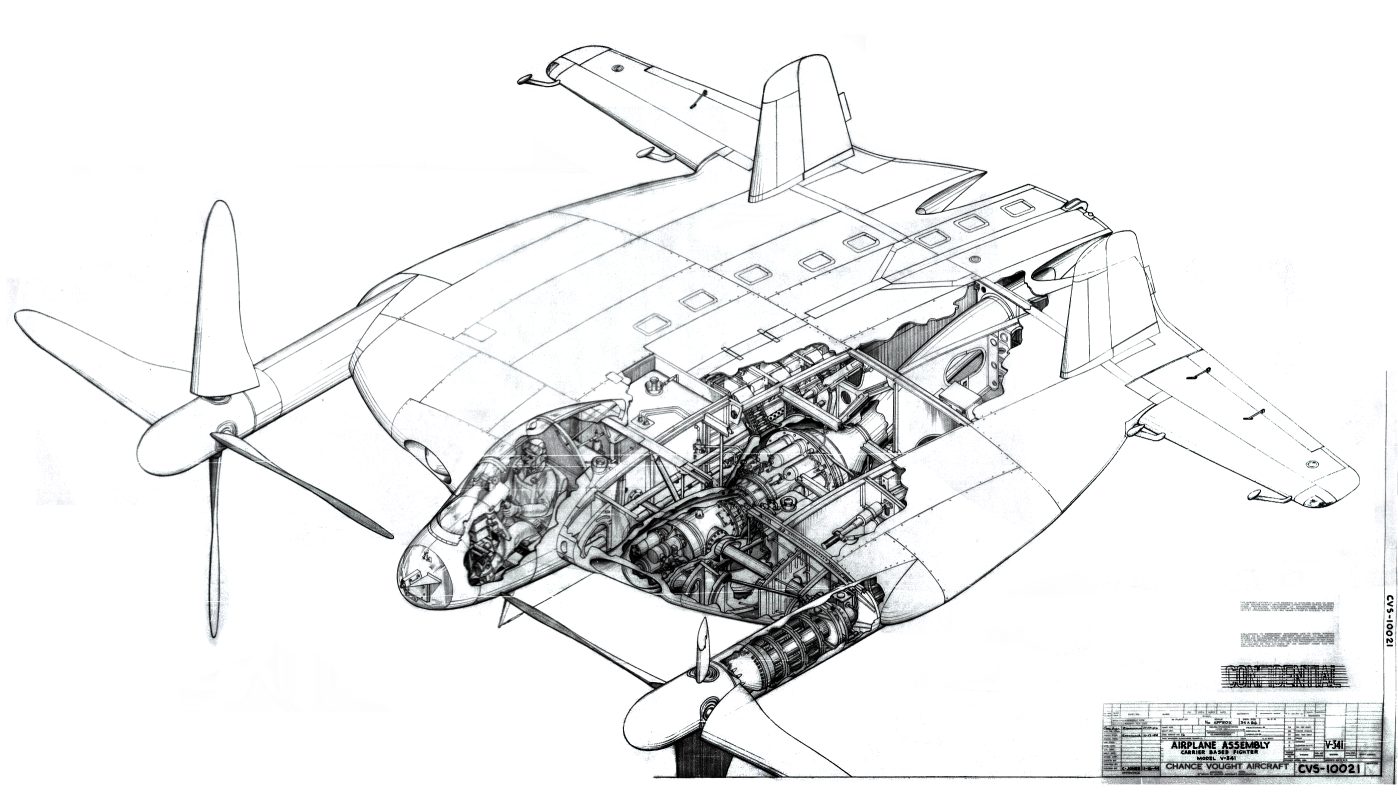Apr 012010
For those of you who use MS Paint or Powerpoint to “illustrate” concepts, look upon this example of real artwork and despair. This is a cutaway illustration of the Chance-Vought V-341 carrier based fighter, which would have been capable of nearly VTOL operations.
This is a development of the XF5U-1, two examples of which were built but not flown. The primary difference is the replacement of the two P&W R-2000 radial piston engines with early turboprop engines. This should have made the craft both lighter and more powerful. However, this was not built.
10 Responses to “Now THIS is art!”
Sorry, the comment form is closed at this time.

Although jets could outrun it in the fighter mode, it’s surprising that the design wasn’t looked at as a armed scout or scaled up into a cargo and troop delivery aircraft. In both roles its STOL capabilities would have made it very useful, and I’d have much preferred to fly in one of these in a FAC mission over something like a O-1 “Bird Dog” due to its superior speed if it needed to get away in a hurry.
It certainly would have been a lot safer to operate than the Convair Pogo.
It should have been looked at for the Close Air Support role. It would have probably been designated A-2 and could have been a great attack/close air support aircraft. Also, it should have been built for no other reason than to look into the aerodynamics of the design. So much could have been learned that was tossed away.
Oh, and it wasn’t that they needed a wrecking ball to scrap it, they dropped a wrecking ball on it’s spine to try to break it in half, but they hit it twice and the spine held, so they had to drop the ball on the wings and punch holes in the wings instead. They also had to use saws and torches. It was much overbuilt and some suggest that had it completed development, it could have been built about 2/3 as heavy.
The idea of using turboprops would have made this thing a magnificent aircraft.
Some sources cite a speed range from 50 – 550 mph. But that is not correct, the propellers limitations suggest a speed limitation of 460 mph but a climb of nearly 4,000 ft per minute. Given developmental time the top speed could have risen to about 500 mph.
It’s a shame they at least could have test flown the thing instead of destroying it with a wrecking ball. At least if it crashed it would have
gone down honorably. It just makes us look bad,as in other cases as well.
Any indication what type engines those are?
Based on their burner can layout, they look like General Electric T31 turboprops, or at least some variant of the J31 turbojet engine:
http://en.wikipedia.org/wiki/General_Electric_T31
The accessories on the front of the gearbox also look a lot like those found on the front of the J31.
The time frame is also correct for them being T31s.
Vought corporate relative P&W wouldn’t have been happy if that’s the case. I wonder if it was a P&W concept engine.
The diameter of these engines is small enough that the fairings for the radials aren’t needed any longer, so the installation would have been a lot cleaner.
That could be the case, as P&W did take a crack at building their own design jet engines right after the war, but had to settle for making license-built versions of the RR Nene and Tay due to lack of sufficient capital to get their own designs into production.
Maybe it’s supposed to be some sort of turboprop Nene variant using a large diameter rear free turbine to provide power to the front gearbox.
That would certainly simplify spinning up the giant props.
One other possibility here is that these are some sort of turboprop development by P&W of the Rolls-Royce W.2B/23 Welland turbojet engine or one of its close relatives like the W2/500 or W2/700.
All three of those use the parallel-mounted burner can arrangements visible in the aircraft cutaway, and there are photos of them around halfway down this webpage: http://plane-crazy.purplecloud.net/Aircraft/Jets/E28-39/gloster_e2839.htm
Those appear to be General Electric T-31 Turboprop engines in there:
https://en.wikipedia.org/wiki/General_Electric_T31
Note the combustion chamber arrangement. (an odd reverse-flown arrangement somewhat like Whittle’s, but coupled with an axial compressor related to the J35 turbojet)
https://airandspace.si.edu/collection-objects/general-electric-t31-tg-100-turboprop-engine-cutaway
Another view of the T31, though grainy. The engine seems rather large and heavy to replace the R-2000 engines used in the XF5U. Rolls Royce’s Dart turboprop seems a much better fit, but it seems like any engines mounted in that embedded position would have been a problem given the vibrations from the transmission shafts that prevented the XF5U from flying at all. (OTOH, the Dart may have been small and light enough to be mounted directly in the wing-tips, avoiding that shaft entirely)
It also may have been possible to mount two small piston engines on the wing-tips (like V-775s) with smaller propellers intended to only provide sufficient airflow over the wing surfaces to create the desired vortex effect (improving lift and lift to drag ratio) and embed a pair of J31 jet engines in place of the R-2000 engines, providing 3,300-4,000 lbs of combined thrust (depending on model) on top of the 520 hp of each piston engine) It would’ve been a more interesting mixed-powered aircraft than any actually attempted by the USN in that period, a genuinely high-speed capable STOL fighter.
There’s also the J36, a licensed Halford H1 Goblin, but that was never produced beyond one or two flight-worthy prototypes (Used in the Curtiss XF15C), and by the time the Navy would’ve been serious about it, licensing Rolls Royce’s lighter and more powerful Derwent V to replace the J31 would have been far more appealing: the Navy would end up using the larger Nene licensed as the J42 later on, so the Derwent V seems plenty plausible as well.